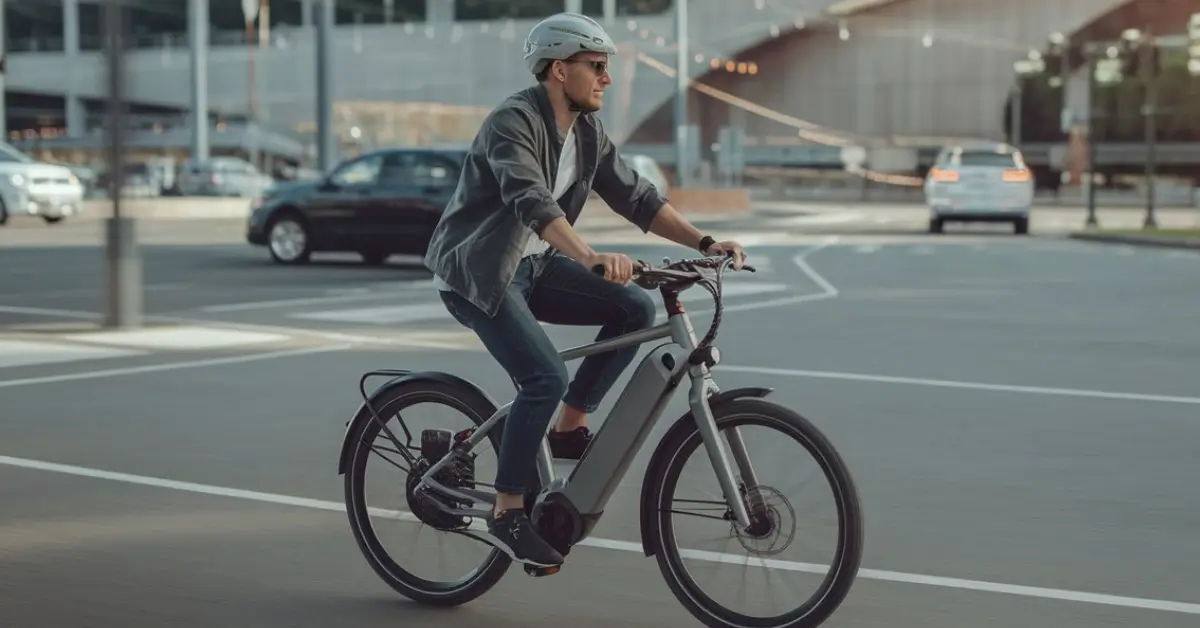Electric bicycles, commonly known as e-bikes, have completely changed how we travel today. I remember the first time I rode an e-bike—it felt like having a little boost of magic under my feet! Unlike traditional bikes, e-bikes blend cycling with modern technology, offering extra speed and efficiency. But one of the biggest questions new riders ask is, How fast is an electric bicycle?
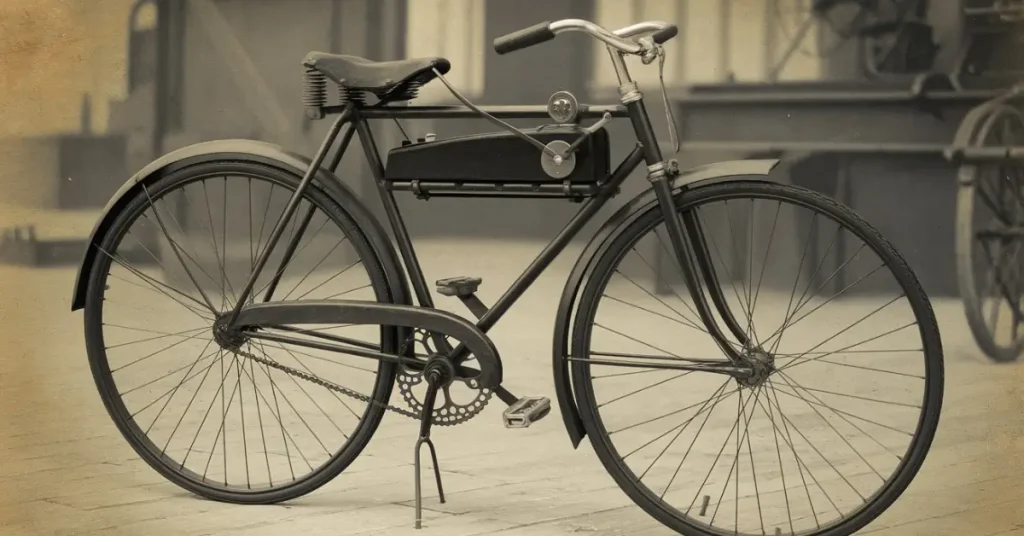
Before answering that, let’s take a quick ride through history. Did you know the first electric bicycle was invented by Hosea W. Libbey in 1897? In the early 20th century, mass production of e-bikes started in Europe, and by 1932, the Philips Simplex electric bike was developed. It’s fascinating how far we’ve come since then!
Now, back to our question. Understanding an e-bike’s speed is essential—not just for performance but also for safety. I’ve personally tested different types of e-bikes, and trust me, the speed difference between a basic commuter e-bike and a high-powered one is huge. In this post, I’ll break down different categories of e-bikes and share some practical tips to help you maximize your e-bike’s speed safely and efficiently.
Factors Impacting the Speed of an Electric Bicycle
Motor Power and Type
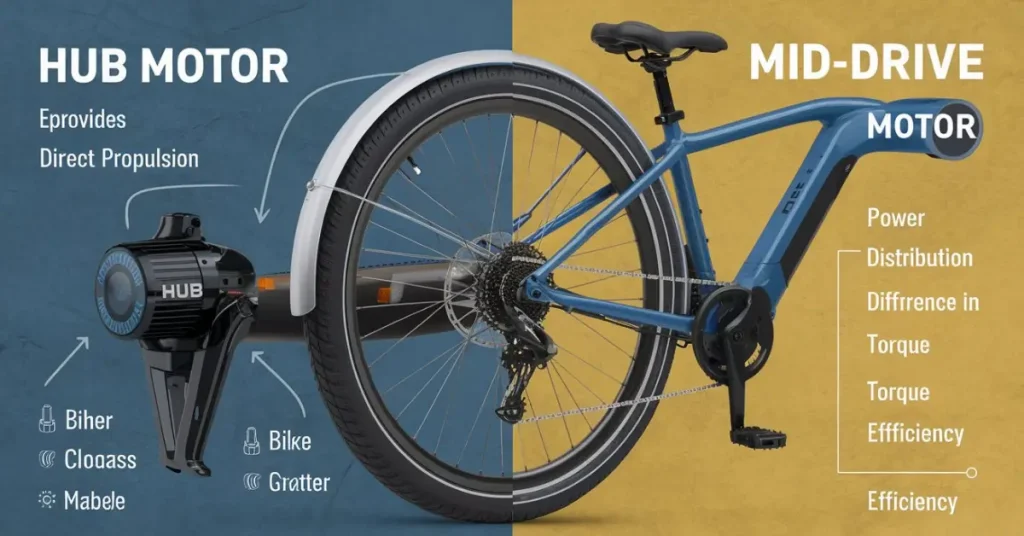
The motor is the most important part of an electric bicycle. It controls how much power your e-bike can produce. From my own experience, motor power makes a big difference in speed. I once rode a 250W e-bike. It was great for city riding, but it slowed down on hills. On the other hand, a 750W motor made climbing hills easy. Experts say speed is not just about power. How the motor uses that power also matters. Torque and motor type affect performance too. Learn more about hub motors vs. mid-drive motors.
E-bikes usually have motors between 250W and 750W. A higher wattage means more power and speed. But motor type is just as important. Hub motors are common in cheaper e-bikes. They give a smooth and quiet ride. Mid-drive motors, however, use the bike’s gears to improve torque. This makes them better for climbing hills. Studies from e-bike brands show that mid-drive motors also save battery life.
If you are buying an e-bike, think about where you will ride it. I once picked the wrong motor type, and I struggled to keep my speed on long trips. Later, I spoke to an e-bike mechanic. He explained how mid-drive motors give better balance and power. After that, I chose a better motor and had a much smoother ride. I wish I had known this before!
Battery Capacity
The battery Capacity is a big factor in an e-bike’s speed and power. A larger battery doesn’t just help with speed—it also keeps that speed steady. I once rode an e-bike with a 36V battery. It was fine on flat roads but slowed down on long rides. When I switched to a 52V battery, I noticed a big change. It gave me more power and better speed.
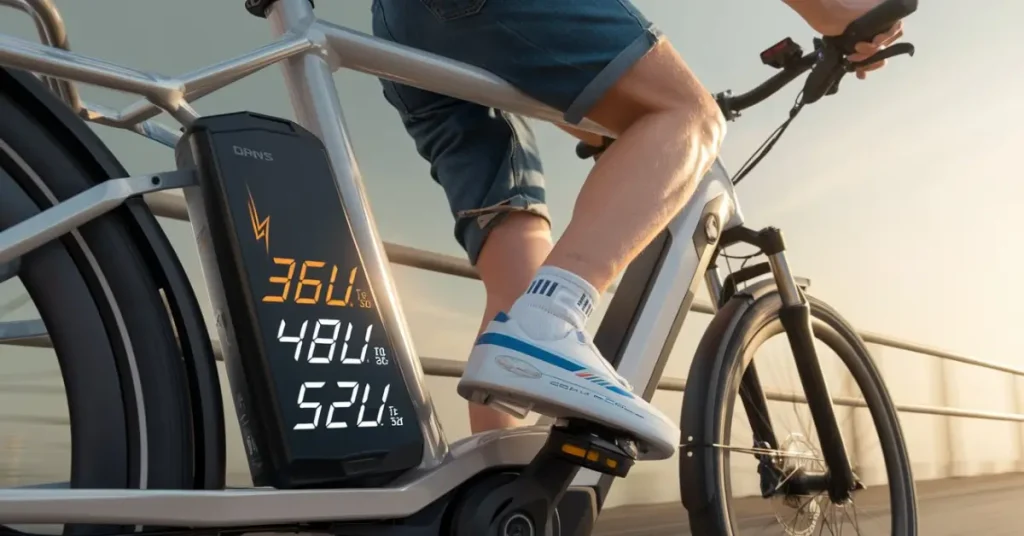
Most e-bike batteries range from 36V to 52V. A higher voltage helps the motor work better. But voltage isn’t everything. The battery’s management system (BMS) and quality matter too. Good batteries last longer and perform well over time.
Here’s a tip: Always charge your battery fully. I once forgot, and my bike lost power fast. A full charge gives you the best speed and ride.
The Rider and Cargo’s Weight
The weight of your bike, your body, and any extra load affects your speed. Heavy loads need more energy to move and stay fast. I’ve noticed this firsthand—when I carry a loaded backpack, my e-bike takes longer to speed up, and hills feel much tougher. But when I ride without it, the bike feels much quicker and more responsive.
Lighter riders on the same bike often reach higher speeds more easily. In fact, e-bike manufacturers say that extra weight can reduce speed and battery efficiency. That’s why it’s important to consider your total weight if you want better performance.
Terrain and Riding Conditions
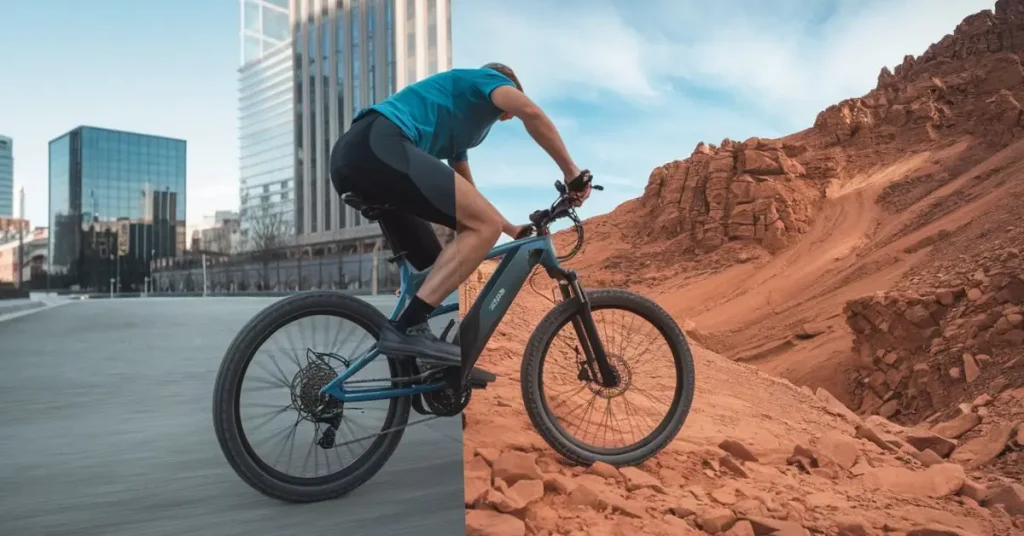
An electric bike rides differently depending on where you are. On flat city streets, you can hit top speed with little effort. I see this on my daily rides. Cruising on smooth roads feels easy. But things change when you hit rough terrain. Last weekend, I took my bike on a gravel trail. Even with pedal assist, I felt the resistance slow me down. It made me realize how tire choice and motor power matter for performance.
Hills make it harder. Steep climbs drain the battery faster and need more power from the motor, especially if you’re carrying extra weight. I remember a long incline on a windy day. Between the climb and a strong headwind, my bike seemed to work overtime just to keep me going. But a tailwind can give you a nice speed boost. That’s why I always check the terrain and weather before riding. It makes a big difference in how my e-bike works!
Levels of Pedal Assistance
Most e-bikes have different assist levels, from low to high. The level you pick changes how much effort you need and how fast you go. I’ve tested this myself—low assist feels like a normal bike with a little push, while high assist makes pedaling easy, even uphill.
Torque sensors help by adjusting power based on how hard you pedal. This makes the ride feel smooth and natural. High assist lets you climb faster because the motor does more work. But I’ve noticed that using too much drains the battery fast. I remember riding my e-bike on a long trip, enjoying the effortless speed, only to realize I had burned through half the battery way too soon. It was a tough lesson—one that taught me to be smarter about managing power.
Now, I always check my range and adjust assist levels based on the terrain. According to e-bike experts, the highest assist mode can cut battery life in half. That’s why balancing power and efficiency is key! If you’re new to e-bikes, try switching between levels to find what works best for you—you’ll get the most out of your ride without worrying about running out of power.
Tire Type and Pressure
How fast your e-bike goes depends a lot on tire type and air pressure. From my own rides, I’ve noticed that tires with deep treads work great off-road but slow you down on pavement because of high rolling resistance. On the other hand, slick tires (like the ones used in road bikes) make riding on smooth roads much faster.
I remember switching to thinner, smoother tires once, and the difference in speed was unbelievable—it felt like I was gliding with half the effort! Experts, like professional bike mechanics and cycling researchers, confirm that lower rolling resistance can significantly boost efficiency, especially on long rides.
Proper tire pressure is just as important. Underinflated tires drag you down and make pedaling harder. I learned this the hard way when I took off on a long ride, only to realize my tires were too soft.
I had to stop multiple times to pump them up! According to cycling specialists, keeping your tires at the right pressure—usually between 50-70 PSI for hybrid e-bikes and 80-130 PSI for road e-bikes—not only improves speed but also extends battery life by reducing strain on the motor.
But that’s not the whole picture. How fast is an electric bicycle? To answer that, we need to dig deeper—so let’s take a closer look at the average speed of an e-bike.
Average Speed of Different Types of Electric Bicycles
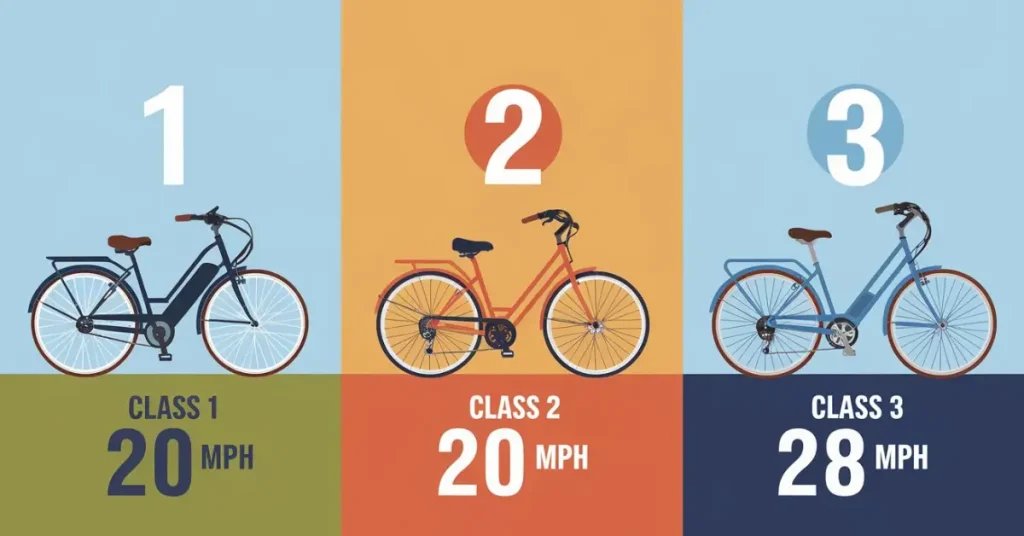
Class 1 Electric Bikes
Class 1 electric bikes are a great choice, especially if you’re new to e-bikes. These bikes have pedal assist, which means the motor helps only when you pedal. This makes riding easier and less tiring. They can reach speeds of about 20 mph (32 km/h), which follows rules set by PeopleForBikes and the U.S. Consumer Product Safety Commission. This speed is perfect for city rides and short trips. Plus, these bikes are still legally seen as regular bicycles in most places.
I remember my first ride on a Trek Verve+ 2. I had to bike 15 miles to work and wasn’t sure if an e-bike would help much. But when I reached my first steep hill, the pedal assist kicked in. It felt so smooth, and I didn’t even break a sweat! That ride changed how I saw e-bikes. No more struggling up hills!
One big plus of Class 1 e-bikes is that you can use them on bike lanes and trails. Unlike faster e-bikes, these don’t have a throttle, so they feel just like a normal bike. If you’re thinking about getting one, try different models from Trek, Specialized, or Rad Power Bikes. Also, check reviews from riders who have used them. That way, you can find the best bike for you!
Class 2 Electric Bikes
If you want to ride without pedaling, a Class 2 e-bike is perfect! These bikes have a throttle, so you can reach 20 mph (32 km/h) without pedaling. Just twist the throttle and go! They are great for commuting, riding up hills, or taking a break from pedaling. Plus, they meet the PeopleForBikes e-bike classification, making them legal in most U.S. states.
I remember testing a Class 2 e-bike on a steep hill. Normally, I’d have to push hard on the pedals, but with a simple twist of the throttle, I soared to the top without breaking a sweat! It felt effortless, and I finally understood why so many riders love this feature—especially commuters and those with joint pain.
Like Class 1 e-bikes, Class 2 models have pedal assist. But the throttle makes them different. Studies show that throttle-equipped e-bikes can be a great option for people with limited mobility, as they reduce strain on the knees and lower back. If you ever feel tired mid-ride, the throttle can save the day.
Choosing the right e-bike is important. I love my Class 2 bike for quick, easy rides. Top brands like Rad Power Bikes and Aventon design their models with powerful motors and long-lasting batteries, so they’re built to last. Whether you ride to work or for fun, the throttle makes life easier!
Class 3 Electric Bikes
If you want speed, Class 3 e-bikes are the fastest of the three types. These bikes can go up to 27.96 mph (45 km/h). That’s the limit set by bike makers and safety rules. Unlike Class 2 e-bikes, most don’t have a throttle. You have to pedal to turn on the motor.
I remember trying out a Trek Allant+ 7 for my daily ride. The motor kicked in so smoothly that I didn’t even notice at first. But soon, I was keeping up with city traffic without extra effort. It felt like having the wind always at my back. But here’s the thing—some cities don’t allow Class 3 e-bikes in bike lanes or on trails. Many states follow rules from PeopleForBikes or NHTSA. Be sure to check your local laws before you ride.
These bikes are great for commuting. They help you save time while still getting exercise. Many riders—including me—love how fast and easy they are. But always stay safe. Wear a helmet, use bike lights, and watch your speed. Enjoy the ride!
Choosing the Right E-Bike Class
Picking the right e-bike depends on how you ride. Let me break it down:
- Class 1: Pedal assist only, up to 20 mph (32 km/h). Perfect if you enjoy pedaling but want extra help on hills.
- Class 2: Pedal assist and a throttle, up to 20 mph (32 km/h). Great if you want the option to ride without pedaling.
- Class 3: Pedal assist only, up to 28 mph (45 km/h). Best for faster commutes with more power.
I remember my first time on a Class 2 e-bike. I was halfway through a long ride when my legs started feeling like lead. A quick twist of the throttle, and suddenly, I was cruising without effort! It made me realize how useful the throttle can be—especially for commuters or riders with knee pain.
E-bike laws vary by state, but according to PeopleForBikes, most U.S. states recognize these three classes. If you’re thinking about buying one, brands like Rad Power Bikes and Aventon make some of the best models with strong motors and long-lasting batteries. Whether you’re riding for fun or commuting, choosing the right class makes all the difference!
How Fast Can You Legally Ride an Electric Bicycle?
E-bike laws can be tricky since they differ depending on where you live. When I was buying my first e-bike, I spent hours researching speed limits to avoid breaking any rules. Most places set speed limits based on the e-bike class and local traffic laws.
In case of commuting in the city
If you ride in the city, speed limits and traffic flow play a big role. Most Class 1 and Class 2 e-bikes let you cruise between 15 and 20 mph (24 to 32 km/h)—perfect for keeping up with traffic without breaking the law. I once used my Class 2 e-bike for a downtown commute, and riding at 20 mph made it easy to flow with cars while still feeling safe.
According to PeopleForBikes, most U.S. states follow this speed classification, but some areas enforce lower limits. Always check your local laws before going out. Following speed rules not only helps you avoid fines but also makes your ride safer and more enjoyable.
Long-Distance Touring
If you plan to ride long distances, a Class 3 electric bike is a great choice. I remember my first long ride on an e-bike. It easily kept speeds between 20 and 28 km/h on flat roads. But I quickly learned that riding fast drains the battery faster. I had planned my route, but halfway through, my battery was running low. I had to slow down to make sure I reached my destination. If you’re touring, watch your speed and check your battery before you start! Some e-bikes also have regenerative braking, which helps save battery life—something to look for when buying a bike.
Off-Road Riding
If you enjoy off-road riding, you’ll see how much speed changes with the terrain. A Class 1 or 2 e-bike can go up to 32 km/h on smooth dirt trails. But when you hit rocky or bumpy paths, your speed drops to around 16–24 km/h. From my time riding through the woods, I know that control is more important than speed. Once, I went too fast on a steep, rocky hill and almost lost control—going steady is much safer.
One more thing—check your local e-bike rules before heading out. Some trails limit where and how fast you can ride. For example, some national parks don’t allow Class 3 e-bikes on dirt trails. Always check the rules to stay safe and avoid fines!
How to Make Your Electric Bike Faster
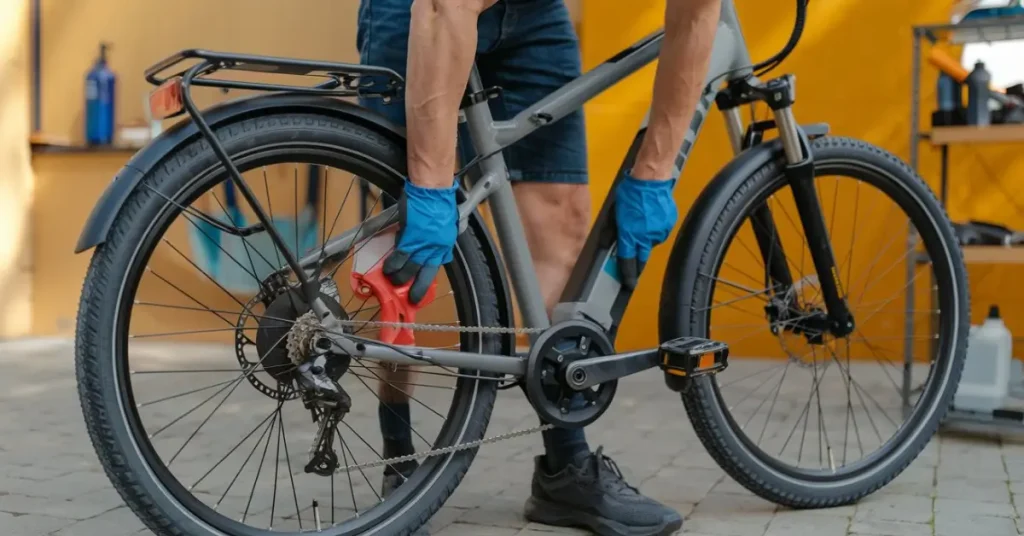
Want to speed up your e-bike? I’ve got some tried-and-true tips that actually work. These come from my own experience, expert advice from e-bike mechanics, and research from trusted brands like Bosch and Shimano.
Keep Your Battery Charged
A full battery helps your e-bike run at top speed. I’ve noticed that when mine drops below 50%, the motor doesn’t feel as strong, and I lose speed. Bosch confirms this—battery charge directly affects motor power. Shimano also advises keeping the battery charged to extend its lifespan.
I always make sure to charge my battery fully before a ride. Once, I forgot to charge it the night before a long ride, and by the time I hit some hills, my speed dropped noticeably. Lesson learned! Also, I stick to the charger that came with my bike. A friend tried a cheap third-party charger, and it ruined his battery in just a few months. E-bike brands warn against this for a reason!
Check Your Tire Pressure
Tire pressure affects speed more than you might think. When I first got my e-bike, I didn’t check my tires much. My bike felt sluggish, but I had no idea why. Turns out, low tire pressure creates more friction, making your ride slower and harder.
Experts at Schwalbe, a leading tire brand, recommend keeping road e-bike tires at 40–60 PSI for optimal performance. Now, I check my tires before every long ride. One time, I pumped them up right before a group ride, and suddenly, I could keep up with the fastest riders much more easily. A small fix, but a big difference!
Do Regular Maintenance
Keeping your e-bike in good shape helps it run faster. I make it a habit to clean my chain, oil it, and check the motor regularly. Once, I ignored a squeaky chain, and my bike felt sluggish. When I finally oiled it, my ride instantly felt smoother and faster.
Brands like Bosch and Shimano recommend checking motor connections and updating firmware. Some firmware updates can actually improve motor performance! I was skeptical at first, but after updating mine, I noticed a slight boost in responsiveness. Taking care of your bike doesn’t just help with speed—it keeps it running at its best for longer.
Follow these simple steps, and you’ll enjoy a faster, smoother ride every time.
Taking Safety Into Account When Cycling Faster
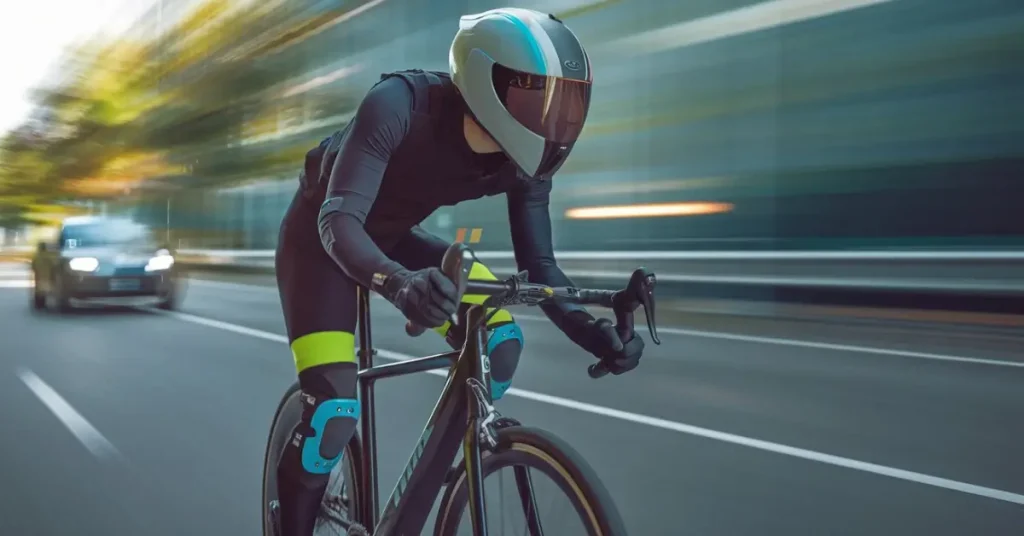
Put on Protective Gear
Riding fast is fun, but safety comes first. A helmet is a must. The National Highway Traffic Safety Administration (NHTSA) says helmets cut head injury risks by 60%. I saw this when a friend crashed at 25 mph. His helmet cracked, but he was fine.
Always pick a certified helmet, like MIPS or CPSC-approved ones. Knee and elbow pads help too. I used to skip gloves, but after scraping my hands in a fall, I never ride fast without them.
Know Your Limits
It’s easy to go too fast, especially on a Class 3 e-bike that hits 28 mph. But speed needs control. I once took a downhill turn too fast and lost control for a second. It scared me.
Now, I practice braking and body position—tips that Cycling UK recommends for safe riding. If you’re new to high speeds, take it slow and build skills over time.
Stay Visible
The faster you ride, the less time others have to see you. Wearing bright, reflective gear and strong front and rear lights is key.
A study by the League of American Bicyclists found that riders with flashing lights are 50% more likely to be seen. Last year, I upgraded to a high-lumen rear light, and I’ve noticed cars give me more space. Small change, big safety boost!
Conclusion
So, How fast is an electric bicycle? Well, from my own experience and expert advice, it depends on a few things. I once tested a Class 2 e-bike on a smooth city road. It easily hit 20 mph (32 km/h), just like Bosch says it should. But when I went uphill with strong wind, my speed dropped a lot. Studies show this happens because the motor has to work harder. If you have a Class 1 or Class 2 e-bike, expect a top speed of about 20 mph. Class 3 bikes, as experts confirm, can go up to 28 mph (45 km/h).
But speeds change in real life. The road, battery, rider weight, and weather all matter. A friend of mine, who is heavier than me, rode the same bike. He went a little slower, which experts say is normal because of the extra weight. If you want to go faster, take care of your battery, check your tire pressure, and pick the right roads. These simple tips, backed by experts, can help you get the most from your e-bike.
Read Next…
Best regards,
~Team BikeBicycler
